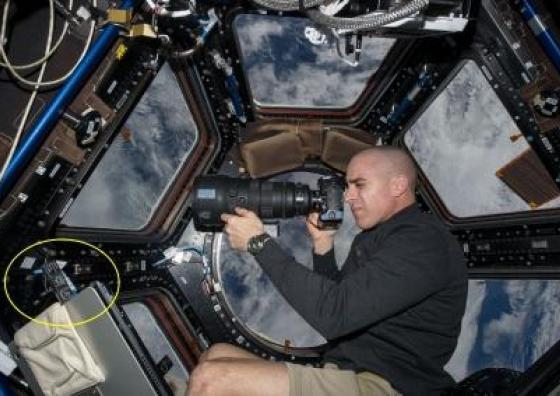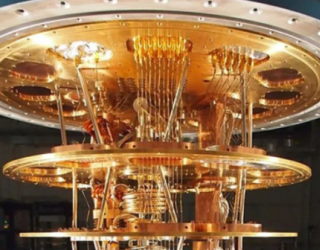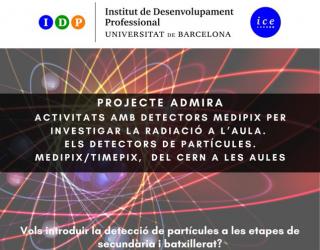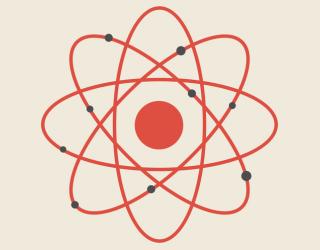ADMIRA Project: Activities with Medipix Detectors to Research Radiation in the Classroom
This project is the result of the commitment of people from three well-differentiated and, nevertheless, fully interconnected areas: schools, universities and research centers. The three motors of the project are:
Rafael Ballabriga
Rafael Ballabriga y Suñé studied at the Ramon Llull University [Telecommunications Technical Engineering (2000), and Electronics Superior (2002)]. In 2004 he began a Doctoral Thesis at CERN, Geneva (Switzerland) in the design of electronic circuits for radiation detection. He currently works in the microelectronics section of CERN.
Rafael Ballabriga supervises PhD students in electronic design. He also makes periodic presentations to young people from schools that visit CERN (between 14 and 18 years) in the field of CERN @ School projects and the recently created IRIS (Institute for Research in Schools).
Eugeni Graugés
Associate Professor at the University of Barcelona (UB). Deputy Dean of Research and Doctorate. Doctor in physics from the Autonomous University of Barcelona (UAB). He has developed his research on high energy physics experiments at CERN (ATLAS, ALEPH and LHCb), Switzerland, and at the SLAC National Laboratory (BaBar), in the United States. He has worked as a researcher at the UAB-IFAE, the University of Oregon, Stanford University, and the University of Maryland-College Park.
Daniel Parcerisas
Head of the Department of Sciences of the Sagrada Família School of Gavà and professor of Physics and Electrical Engineering. Graduate in Physical Sciences at the UAB, he developed the Wish One Space Project project for the launching of a helium balloon in the stratosphere, for which he received the Gavà-Educa prize. He has also worked as a computer consultant at the CORITEL company by scheduling bargaining applications, before doing the leap to teaching.
Starting with a series of occasional collaborations, the project starts the 2017-2018 course, consolidated in 2018-2019 and opens to the participation of other schools in 2019-2020. In order to make this step forward, the collaboration and commitment of many people has been needed.
To all of them, we are greatly grateful: without you this would not have been possible.
Essentially, the project wants to bring research to our students to promote new scientific and technical vocations. Therefore, we want to make available to students instruments and data from real scientific experiments so that they can experiment, be the actors in research projects and contribute to the creation of knowledge. The main theme around which the project revolves is the detection of particles.
We also want to create a network of schools that have access to these instruments and share results of experiments and the data generated. These data will be shared on this website, designed for the exchange of information between schools. At the end of the academic year a conference will be organized in which the students of the participating schools will present the results of their experiments.
We also want to link research centers and universities to the project to bring young students closer to research. We believe that bridges between schools, universities and research centers must be established. Young people should be aware of the excellent research that is being done and we would like to work so that the work of the researchers reaches the students, serving them as inspiration and motivation in their training. We believe that at the moment the students see the world of research as distant and that the fact of establishing contacts would have a very positive impact for all actors.
The project is designed for students to learn by developing an active role in the search for knowledge, concepts about natural radiation (type, sources), data analysis with algorithms and notions of electronics with a methodology in which the different disciplines feedback . Also important is the work in teams and the presentation of projects in public. Participation in the project will provide students with in-depth knowledge in physics, chemistry and mathematics.
In this section we present the relationship between the activities proposed by the students and the secondary and high school curriculum, in order to be able to include the corresponding information.
Educational orientations of the ADMIRA Project
The project has been designed to distribute the activities by courses according to criteria of complexity and affinity with the syllabus of each course, but many of the activities are adaptable to other courses or subjects.
The proposed distribution is as follows:

Lines of action in ESO
The key concepts in Secondary Compulsory related to this project include the achievement of basic competences in the scientific-technological field and key curricular contents, which refer to those capacities that allow students to solve problems based on scientific and technical knowledge, as well as of the dominion of the processes of the scientific activity, that allows to reason and to be critical in situations that consider themselves relevant.
The basic competences of the ESO curriculum related to the different activities of this project would be:

The key contents discussed in this project will be:

Lines of action in the Baccalaureate
In the Baccalaureate the project will focus on the subject of Modality of Physics II, specifying the following objectives and contents:

The ADMIRA Project (Activities with Medipix Detectors to Investigate Radiation in the classroom) aims to create a network of schools around the use of Timepix Detectors designed at CERN. The objective is to bring the Institutes closer to the research done in Universities and Research Centers. A group of schools that have participated in a selection process will use these devices in their classrooms. Teacher training activities will be open to any institute teacher who is interested (with the aim of expanding the network in future editions).
On this website you can consult the objectives of the ADMIRA project, the ways of participating and the activities offered for teachers and students. You can also find the didactic orientations, skills and key contents that are intended to work.
Collaborators of the ADMIRA Project:
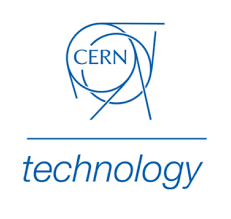

Related Activities and News
ICCUB researcher Sofyan Iblisdir in Sopa de Partículas with the talk “Quantum Computing: a brief introduction”
Roberto Emparan at the Ateneu de Maó with the talk "From Black Holes to the Theory of Everything. Following the steps of Einstein and Hawking"
The Institute of Cosmos Scieneces reseracher and ICREA reseracher, Roberto Emparan, is giving the talk "From Black Holes to the Theory of Everything.
“Cooling down up to the Quantum Realm” by Bruno Julià
The Institute of Cosmos Sciences researcher Bruno Julià will give a talk abou
New cycle of ADMIRA TALKS
The new set of conferences "Admira Talks" will be held from May 28, 2021 to June 14, 2021 and it will consist on a series of 4 lectures given by international experts surroudi
Related Materials of Project
Xerrades ADMIRA: Let’s play with particle physics, Discover radiation everywhere with CERN technology
ADMIRA TALKS - Let’s play with particle physics, Discover radiation everywhere with CERN technology
Xerrada a càrrec de Carlos Granja, Lukas Marek, Jan Jakubek i Patrik Bloudek en el
The Standard Model
Act. 2 ADMIRA - Personification and Modeling of the atom.
Activity 2 ( ADMIRA project)
Guide to perform an activity of modeling the atom using cooperative work and personification, in order to introduce the students of ESO and / or the bacc
Act.1 ADMIRA - Initiation to Medipix. Study of Radiation and its properties. Comparison of classical and relativistic models in alpha and beta radiation.
ACTIVITY 1:

